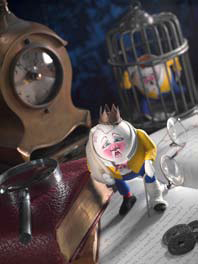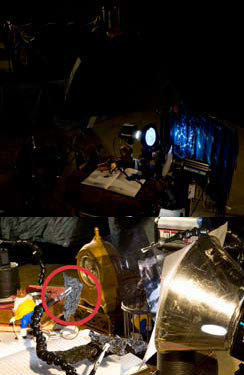articles/Business/table-page4
Tabletop Photography - part 4 of 1 2 3 4
by Dave Montizambert Published 01/11/2006

Lighting breakdown: To light Humpty Dumpty an X2400 Whitelightning monoblock strobe has been placed behind and to the camera's right side of the set. A piece of frosted diffusion material has been taped over the front of the 7" reflector to even out the light. The light from this strobe backlights Humpty. See [1] & [2] to see effect of first light source.
To tone down the back-light, several black foil-wrap gobos and a couple of 2-stop neutral density gels have been suspended between Humpty and the back-light on Grip-it magic arms. See [3].
Some of the strobe light spills past Humpty Dumpty and is rerouted onto the front of him and the surrounding props by five strategically placed foilboard silver card reflectors. See [4] & [5]. To reduce shadow contrast on the set an X1600 Whitelightning monoblock strobe fitted with a 2x3 foot Chimera soft-box is placed over the top of the set. See [6] & [7].
To illuminate the background (my wife's dark blue velvet scarf - I asked first), another X1600 mono-block strobe head fitted with a honeycomb grid and a blue gel, has been placed on a low stand to the camera left side of the background. Another reflector could have been used to light the background if it had not been such a light-eating fabric. See [8] & [9] To stop the camera-right side of Humpty Dumpty from burning out, another piece of black foil is carefully placed so that it feathers some of the backlight off this area. See [10] & main picture.

Fill Reflectors
Fill Reflectors - White versus silver: You may ask, "Why would you ever use white when silver is a more efficient surface for reflecting light?" When considering which to use, efficiency is not the only consideration. The other part of that equation is light quality - a hard light quality or a soft light quality. Hard light means shadow edges that are relatively hard edged. Soft light means shadow edges that are relatively soft edged. Any reflections (called specular highlights) of the fill light source on the subject are generally smaller and brighter from a silver reflector than a white reflector. So you have to ask yourself, do you want any shadows created by the light from this reflector to be hard edged or soft edged and do you want any specular highlights to be brighter or less bright?
Let us go a little deeper: If you had two reflectors of the same dimensions, one white and one silver, the white reflector is more likely to create softer light than would the silver reflector. It all comes down to the area that the bouncing light inhabits on the surface of the reflector before it bounces off - the more area it inhabits the larger the effective size of the fill source will become. If you position your head at the correct angle so that you can see the reflection of the light source (the strobe head on the back right side of the Humpty Dumpty set) on the surface of the fill reflector, you would see a brighter smaller puddle of light in the middle of the silver reflector and you would see a general wash of light over all or most of the surface of the white reflector. So, the silver fill reflector keeps the reflection of the origin light source more focused on its surface, whereas the white fill reflector tends to spread it out much more. In effect the silver surface creates a smaller light source than does the white reflector. Smaller light sources do not see around into the shadows as much as larger sources do, therefore they do not eat into the shadow edges as much as a larger source would - if you allow the light to eat deeper into the shadow by enlarging the light source, it causes softer edged shadows. As for the effect on brightness of glare or sheen (specular highlights) on the subject's surface, a smaller light source creates a smaller brighter specular highlight than does a larger source.
And one final variable, if the light source feeding a silver reflector is relatively large like a soft-box and if the fill reflector is relatively close to that light, then it is possible that the reflection of that light on the surface of the reflector could inhabit the whole area of the reflector creating a light quality that would be just as soft as a white reflector of the same size.
www.montizambert.com Look out for forthcoming titles from Dave Montizambert on lighting (a book) and on High-speed workflows (with Software-cinema).
Please Note:
There is more than one page for this Article.
You are currently on page 4
- Tabletop Photography page 1
- Tabletop Photography page 2
- Tabletop Photography page 3
- Tabletop Photography page 4
1st Published 01/11/2006
last update 09/12/2022 14:59:30
More Business Articles
There are 0 days to get ready for The Society of Photographers Convention and Trade Show at The Novotel London West, Hammersmith ...
which starts on Wednesday 14th January 2026





